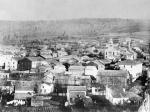![header=[Marker Text] body=[Founded by the Wurts brothers, pioneers in developing anthracite resources of the region, in 1822. Here the first underground mine was opened in June, 1831, near Seventh Ave. Chartered as a city in 1851. ] sign](http://explorepahistory.com/kora/files/1/10/1-A-E9-139-ExplorePAHistory-a0a4t1-a_450.gif)
Mouse over for marker text
Name:
Carbondale
Region:
Poconos / Endless Mountains
County:
Lackawanna
Marker Location:
US 106 North of Carbondale
Dedication Date:
November 12, 1947
Behind the Marker
The Wurts brothers, William and Maurice, helped launch the powerful  Delaware and Hudson Canal Company in the mid-1820s. This corporation, the largest of its time, had big plans for Carbondale. Originally, the company intended the small community to become the grand emporium of northeast Pennsylvania.
Delaware and Hudson Canal Company in the mid-1820s. This corporation, the largest of its time, had big plans for Carbondale. Originally, the company intended the small community to become the grand emporium of northeast Pennsylvania.
Carbondale had important advantages. It was close to the rich anthracite reserves of Lackawanna County and yet it was also not too far from the major market in New York City. The nearby D & H Canal and gravity railroad guaranteed that Carbondale would play a central role in the movement of Pennsylvania coal from mines to markets. It also became home to many "linkage industries" that developed around anthracite production: small shops that specialized in much-needed services, like repairs, or parts. The population in Carbondale grew quickly and soon it was twice the size of more-established Wilkes-Barre.
Carbondale, however, never quite achieved the status its founders had envisioned. There was a multitude of reasons for the community's eventual decline, including a weak municipal infrastructure and an almost complete economic reliance on anthracite. The result was a dangerous and dirty place, "among the dingiest," according to historian Burton Folsom, of some very dingy, nineteenth-century industrial cities.
The underground mines, once the pride of Carbondale, also eventually haunted the troubled community. During the twentieth century, a fire erupted in one of the city's abandoned mines that burned for thirty-three years before it was finally extinguished.
Carbondale had important advantages. It was close to the rich anthracite reserves of Lackawanna County and yet it was also not too far from the major market in New York City. The nearby D & H Canal and gravity railroad guaranteed that Carbondale would play a central role in the movement of Pennsylvania coal from mines to markets. It also became home to many "linkage industries" that developed around anthracite production: small shops that specialized in much-needed services, like repairs, or parts. The population in Carbondale grew quickly and soon it was twice the size of more-established Wilkes-Barre.
Carbondale, however, never quite achieved the status its founders had envisioned. There was a multitude of reasons for the community's eventual decline, including a weak municipal infrastructure and an almost complete economic reliance on anthracite. The result was a dangerous and dirty place, "among the dingiest," according to historian Burton Folsom, of some very dingy, nineteenth-century industrial cities.
The underground mines, once the pride of Carbondale, also eventually haunted the troubled community. During the twentieth century, a fire erupted in one of the city's abandoned mines that burned for thirty-three years before it was finally extinguished.






